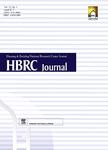版权所有:内蒙古大学图书馆 技术提供:维普资讯• 智图
内蒙古自治区呼和浩特市赛罕区大学西街235号 邮编: 010021

作者机构:Department of Civil Construction-Architectural and Environmental Engineering University of L’Aquila L’Aquila Italy Faculty of Engineering and Technology Architectural Engineering Department Future University in Egypt Cairo Egypt Civil and Environmental Engineering Department Notre Dame University-Louaize Zouk Mosbeh Lebanon Department of Mechanical Engineering Ontario Tech University ON Canada
出 版 物:《HBRC Journal》 (HBRC J.)
年 卷 期:2025年第21卷第1期
页 面:62-80页
核心收录:
基 金:This article concerns a presentation by the authors in the \u201CTechnical Session 1 - Sustainable Urban Mobility Planning\u201D at the UPGRADE International Conference on Sustainable Urban Mobility Planning [ICSUMP] Oct 25\u201326 2023 - Arab Academy for Science Technology & Maritime Transport Alexandria Egypt. The research on which the article is based was funded by UPGRADE an Erasmus+ Joint Regional Project (https://aast.edu/en/scientific-research/upgrade/) aimed at Capacity Building in the field of Higher Education. The project consortium comprises the departments of Architecture Urban Planning and Civil Engineering in eight highly reputable Higher Education Institutes and one Research Center from six different countries. Two of which are Partner Countries (Egypt and Lebanon) where the project was held and four are Program Countries (Germany Italy Greece and Spain) from which the project was supervised
主 题:Sustainable city
摘 要:This paper investigates the integration between different scales of sustainable mobility planning, with particular reference to the integration between Sustainable Urban Mobility Planning (SUMP) and Urban Design. It was carried out in the framework of the EU Erasmus+ UPGRADE project–Urban and transPortation reGeneration for Reducing Automobile Dependency in Middle East and North Africa–MENA area, whose cities are facing major challenges to improve their sustainable mobility. The study uses a comparative method to compare planning models and tools in the European Union, currently limited to the Italian case, with those in the MENA region currently limited to Egypt and Lebanon. On the one hand, the qualitative analysis concerns the integration between sustainable mobility planning and regional and urban spatial planning, looking for relationships (horizontal and vertical coherence checks) and criticalities between them. On the other hand, the analysis concerns the integration of the above levels and types of planning with urban design practices aimed at sustainable mobility. The application of the methodology revealed some criticalities inherent in the processes differentiated according to the countries considered, highlighting key disconnections between SUMP and Urban Mobility Design practices. The next steps of the research will be to expand the case studies and search for good practices in urban mobility design. © 2024 The Author(s). Published by Informa UK Limited, trading as Taylor & Francis Group.